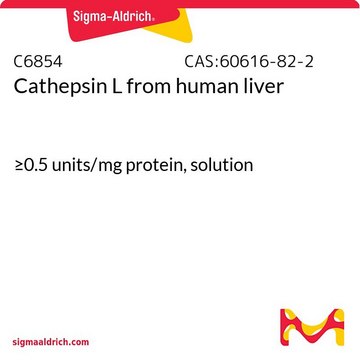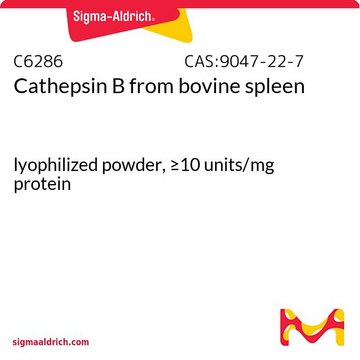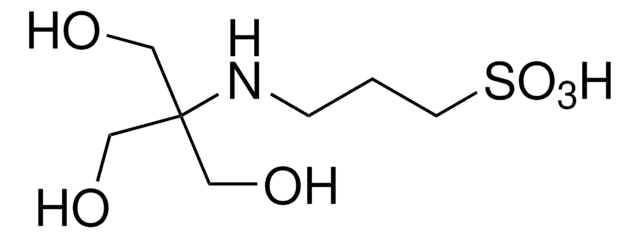219461
Cathepsin K, His•Tag®, Human, Recombinant, E. coli
Cathepsin K, His•Tag, Human, Recombinant, E. coli, CAS 94716-09-3, of the papain superfamily of cysteine proteinases plays a role in osteoclast-mediated bone resorption and collagen degradation.
Iniciar sesiónpara Ver la Fijación de precios por contrato y de la organización
About This Item
Número de CAS:
Código UNSPSC:
12352202
NACRES:
NA.77
Productos recomendados
recombinante
expressed in E. coli
Nivel de calidad
Análisis
≥95% (SDS-PAGE)
formulario
liquid
actividad específica
≥900 mU/mg protein
fabricante / nombre comercial
Calbiochem®
condiciones de almacenamiento
OK to freeze
avoid repeated freeze/thaw cycles
Condiciones de envío
wet ice
temp. de almacenamiento
−70°C
Descripción general
Cathepsin K is a member of the papain superfamily of cysteine proteinases and plays an important role in osteoclast-mediated bone resorption and collagen degradation. It is primarily expressed by osteoclasts and recent studies also suggest its expression in fibroblasts. Irregularities in cathepsin K activity, either too high or too low, contribute to osteopenic disorders such as osteoporosis and pycnodysostosis. This recombinant enzyme contains a C-terminal His•Tag sequence.
Cathepsin K is a member of the papain superfamily of cysteine proteinases and plays an important role in osteoclast-mediated bone resorption and collagen degradation. It is primarily expressed by osteoclasts. Recently reported to also be expressed in fibroblasts. Irregularities in activity contribute to osteopenic disorders such as osteoporosis and pycnodysostosis. Contains a C-terminal His•Tag.
Note: 1 mU = 1 milliunit.
Envase
Please refer to vial label for lot-specific concentration.
Advertencia
Toxicity: Standard Handling (A)
Definición de unidad
One unit is defined as the amount of enzyme that will hydrolyze 0.4 µmol Z-FR-AMC per min at 37°C, pH 5.5.
Forma física
In 50 mM NaOAC, pH 5.5. The activation was stopped by addition of 10 mM MMTS, which can be removed under reducing conditions.
Reconstitución
Following initial thaw, aliquot and freeze (-70°C).
Otras notas
Delaisse, J.M., et al. 2003. Microsc. Res. Tech.61, 504.
Dodds, R.A. 2003. Cell Biochem. Funct.21, 231.
Everts, V., et al. 2003. Calcif. Tissue Int.73, 380.
Hou, W.S., et al. 2003. Biol. Chem.384, 891.
Dodds, R.A. 2003. Cell Biochem. Funct.21, 231.
Everts, V., et al. 2003. Calcif. Tissue Int.73, 380.
Hou, W.S., et al. 2003. Biol. Chem.384, 891.
Información legal
CALBIOCHEM is a registered trademark of Merck KGaA, Darmstadt, Germany
HIS TAG is a registered trademark of Merck KGaA, Darmstadt, Germany
Código de clase de almacenamiento
12 - Non Combustible Liquids
Clase de riesgo para el agua (WGK)
nwg
Punto de inflamabilidad (°F)
Not applicable
Punto de inflamabilidad (°C)
Not applicable
Certificados de análisis (COA)
Busque Certificados de análisis (COA) introduciendo el número de lote del producto. Los números de lote se encuentran en la etiqueta del producto después de las palabras «Lot» o «Batch»
¿Ya tiene este producto?
Encuentre la documentación para los productos que ha comprado recientemente en la Biblioteca de documentos.
Xiao-Yu Yuan et al.
Bioorganic & medicinal chemistry, 27(6), 1034-1042 (2019-02-19)
Selective proteinase inhibitors have demonstrated utility in the investigation of cartilage degeneration mechanisms and may have clinical use in the management of osteoarthritis. The cysteine protease cathepsin K (CatK) is an attractive target for arthritis therapy. Here we report the
Nuestro equipo de científicos tiene experiencia en todas las áreas de investigación: Ciencias de la vida, Ciencia de los materiales, Síntesis química, Cromatografía, Analítica y muchas otras.
Póngase en contacto con el Servicio técnico








